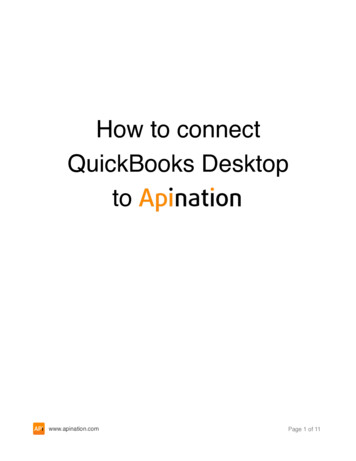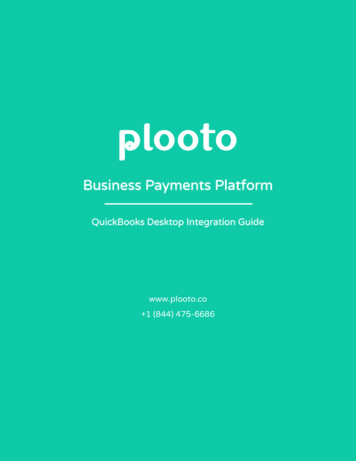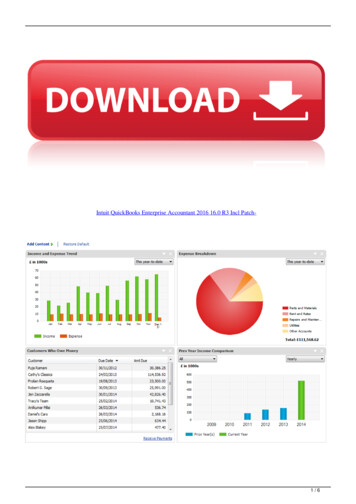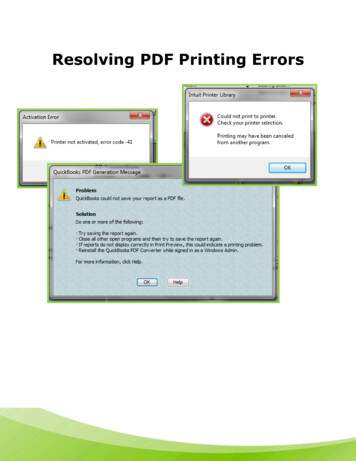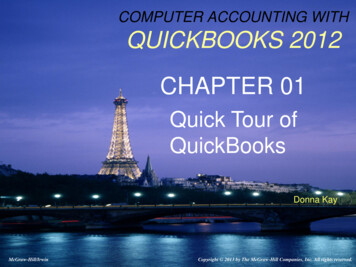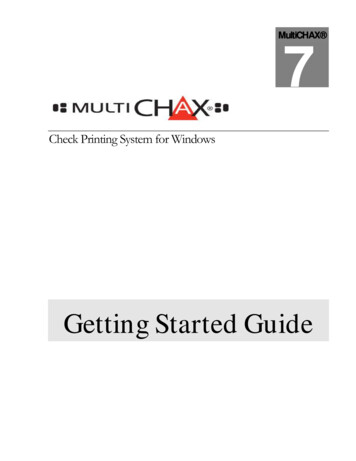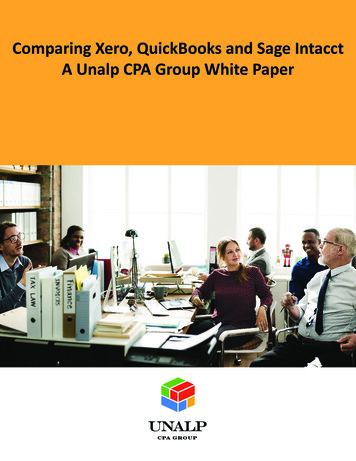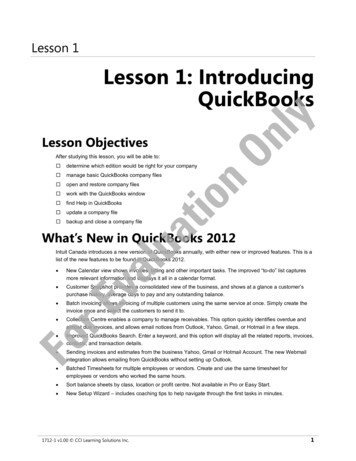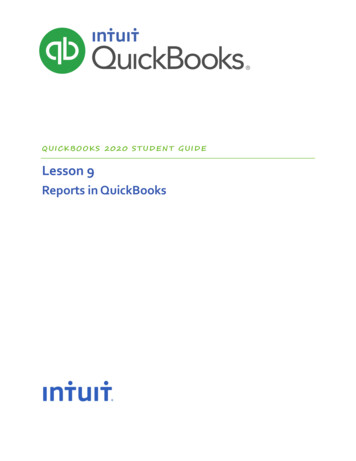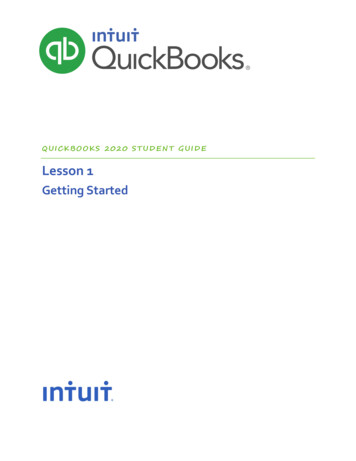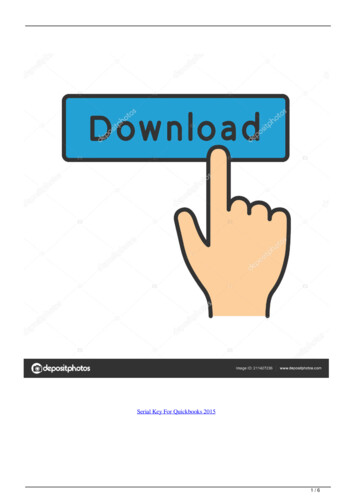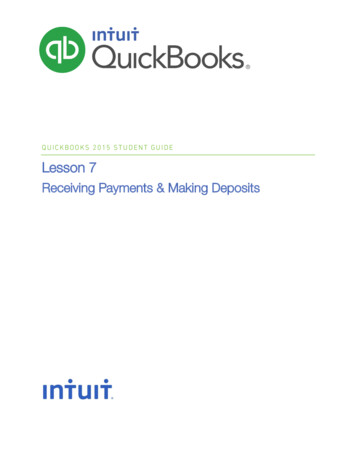
Transcription
QUICKBOOKS 2015 STUDENT GUIDELesson 7Receiving Payments & Making Deposits
CopyrightCopyright 2015 Intuit, Inc.All rights reserved.Intuit, Inc.5601 Headquarters DrivePlano, TX 75024Trademarks 2015 Intuit Inc. All rights reserved. Intuit, the Intuit logo, Intuit ProLine, Lacerte, ProAdvisor,ProSeries and QuickBooks, among others, are trademarks or registered trademarks of Intuit Inc. inthe United States and other countries. Other parties’ marks are the property of their respectiveowners.Notice to ReadersThe publications distributed by Intuit, Inc. are intended to assist accounting professionals in theirpractices by providing current and accurate information. However, no assurance is given that theinformation is comprehensive in its coverage or that it is suitable in dealing with a client’s particularsituation. Accordingly, the information provided should not be relied upon as a substitute forindependent research. Intuit, Inc. does not render any accounting, legal, or other professional advicenor does it have any responsibility for updating or revising any information presented herein. Intuit,Inc. cannot warrant that the material contained herein will continue to be accurate nor that it iscompletely free of errors when published. Readers should verify statements before relying on them.
Lesson 7 — Receiving Payments & Making DepositsTable of ContentsTable of ContentsLesson Objectives . 4Recording Payment in Full for a Single Job . 5Entering a Partial Payment . 6Applying One Payment to Multiple Jobs . 7Entering Overpayments. 8Handling Down Payments & Prepayments . 9Making Deposits . 12How QuickBooks Handles the Deposit . 15How to Handle a Customer Bounced Check . 16Receiving Payments & Making Deposits — Review Questions . 19Review Activities. 20Answers to Review Questions . 21QuickBooks 2015 Student Guide3
Lesson 7 — Receiving Payments & Making DepositsLesson ObjectivesLesson ObjectivesTo learn how to record customer payments in QuickBooksTo learn how to handle customer discounts, partial payments, overpayments, or down paymentsTo learn how to handle customer bounced checksTo see how to record a deposit in QuickBooks and how QuickBooks treats the deposit behind the scenesTo learn how to enter cash back from a deposit in QuickBooksQuickBooks 2015 Student Guide4
Lesson 7 — Receiving Payments & Making DepositsRecording Payment in Full for a Single JobRecording Payment in Full for a Single JobIf you’re receiving payment at the time of a sale and you fill out a sales receipt, QuickBooks records a customerpayment. When you invoice a customer and you receive payment later, you enter the payment in the QuickBooksReceive Payments window.To record a payment in full:1. From the Customers menu, choose Receive Payments.2. If the QuickBooks Payment Interview window displays, close it.In the Received From field, select the customer:job that you are receiving payment from.3. Press Tab to move to the Amount field.4. In the Amount field, type in the amount of the payment.5. Select the payment method from the payment icons then press Tab.6. Enter the reference number for the payment, if applicable.7. Place a check mark next to the invoices in the grid that you are applying the payment to.8. Click Save & Close.NOTESQuickBooks 2015 Student Guide5
Lesson 7 — Receiving Payments & Making DepositsEntering a Partial PaymentEntering a Partial PaymentTo enter a partial payment:1. From the Customers menu, choose Receive Payments.2. In the Received From field, select the customer:job that you are receiving payment from.3. In the Amount field, type in the amount of the payment.4. Select the payment method from the payment icons then press Tab.5. Enter the reference number for the payment, if applicable.6. Place a check mark next to the invoices in the grid that you are applying the payment to.7. Leave the Leave this as an underpayment option selected.8. Click Save & Close to record the partial payment.NOTESQuickBooks 2015 Student Guide6
Lesson 7 — Receiving Payments & Making DepositsApplying One Payment to Multiple JobsApplying One Payment to Multiple JobsTo apply one payment to multiple jobs:1. In the Receive Payments window, select the parent customer name for the jobs you are receiving paymentagainst. This will enable QuickBooks to show all open invoices for the parent customer and jobs.2. In the Amount field, type in the amount of the payment.3. Select the payment method from the payment icons then press Tab.4. Enter the reference number for the payment, if applicable.5. Place a check mark next to the invoices in the grid that you are applying the payment to.6. Click Save & Close.NOTESQuickBooks 2015 Student Guide7
Lesson 7 — Receiving Payments & Making DepositsEntering OverpaymentsEntering OverpaymentsIf a customer sends you an overpayment, you simply enter the amount in the Receive Payments window andQuickBooks keeps track of the additional payment. When the customer has future invoices, you can apply theoverpayment to those amounts — you can even apply the credit directly to the invoice.To enter the payment:1. In the Received From field, select the customer:job that you are receiving payment from.2. In the Amount field, type in the amount of the payment.3. Select the payment method from the payment icons then press Tab.4. Enter the reference number for the payment, if applicable.5. Place a check mark next to the invoices in the grid that you are applying the payment to.6. You may choose Leave the credit to be used later to leave the overpayment on the customer account or Refundthe amount to customer to issue a refund.7. Click Save & Close.a. If you chose to refund the amount to your customer, the Issue a Refund window will appear. Complete theform appropriately.b. Click OK.QuickBooks 2015 Student Guide8
Lesson 7 — Receiving Payments & Making DepositsHandling Down Payments & PrepaymentsHandling Down Payments & PrepaymentsIf a customer makes a payment before you’ve invoiced him for services (for example, he may be making a downpayment or paying a retainer fee), you can still record the payment in the Receive Payments window. However,because you don’t have any invoices to apply the payment to, QuickBooks records the payment as an unusedpayment (just like an overpayment).QuickBooks holds the unapplied amount with the customer’s name. The next time you enter that customer in theReceive Payments window, QuickBooks displays the credit amount in the Unused Credits area. The customer’sbalance also reflects the credit amount.To enter the down payment:1. In the Received From field, select the customer:job that you are receiving payment from.2. In the Amount field, type in the amount of the payment.3. Select the payment method from the payment icons then press Tab.4. Enter the reference number for the payment, if applicable.5. Ensure that no invoices are selected to apply the payment to.QuickBooks 2015 Student Guide9
Lesson 7 — Receiving Payments & Making DepositsHandling Down Payments & Prepayments6. Leave the Leave the credit to be used later option selected.7. Click Save & Close.8. Click OK.To create an invoice for a customer who made a down payment:1. From the Customers menu, choose Create Invoices.2. In the Customer:Job field, select the customer you are creating the invoice for.3. Add any billable time/costs, if applicable.4. If you use custom invoice templates, select the appropriate template from the Template drop-down.5. Complete the invoice form appropriately.6. Click Apply Credits to apply the down payment amount toward this invoice.QuickBooks 2015 Student Guide10
Lesson 7 — Receiving Payments & Making DepositsHandling Down Payments & Prepayments7. Choose the credits you wish to apply to the invoice and click Done.8. Click Save & Close to record the transaction.NOTESQuickBooks 2015 Student Guide11
Lesson 7 — Receiving Payments & Making DepositsMaking DepositsMaking DepositsWhen you use the Enter Sales Receipt window (for a sales receipt where you receive payment on the spot), theReceive Payments window (for payments on invoices), or a payment item on an invoice, QuickBooks keeps track ofthe money you’ve received until you deposit it in the bank. When you receive payments from customers, you caneither deposit each payment directly into a QuickBooks bank account or you can group payments together into anaccount called Undeposited Funds to be moved to that bank account at a later time. QuickBooks allows you tochoose the method you prefer for depositing payments.To select payments to deposit:1. From the Banking menu, choose Make Deposits.QuickBooks 2015 Student Guide12
Lesson 7 — Receiving Payments & Making DepositsMaking Deposits2. Click to select the payments you want to bring to the bank.3. Click OK.QuickBooks displays the Make Deposits window, which shows the payments you just selected.QuickBooks 2015 Student Guide13
Lesson 7 — Receiving Payments & Making DepositsMaking Deposits4. In the Deposit To field, make sure the proper bank account is selected.If you have money to deposit that is not the result of a payment you received for a sale, you can enter it in the detailarea of the window. For example, if you received a premium refund from your insurance vendor you would enter ithere.5. Click Save & Close to record the deposit.NOTESQuickBooks 2015 Student Guide14
Lesson 7 — Receiving Payments & Making DepositsHow QuickBooks Handles the DepositHow QuickBooks Handles the DepositTo view the Undeposited Funds account:1. From the Lists menu, choose Chart of Accounts.2. In the Chart of Accounts, double-click the Undeposited Funds account.This is the register where QuickBooks records all payments posted to Undeposited Funds.NOTESQuickBooks 2015 Student Guide15
Lesson 7 — Receiving Payments & Making DepositsHow to Handle a Customer Bounced CheckHow to Handle a Customer Bounced CheckWhen a Customer Payment check is returned by the bank:1. Open the Customer Center from the Customer drop-down menu (or press CTRL J)2. Highlight the Customer:Job from the list, then double-click on the payment transaction from the transaction list toopen it.3. Select the Record Bounced Check icon .4. Enter any bank fees charged by your bank for the NSF transaction.QuickBooks 2015 Student Guide16
Lesson 7 — Receiving Payments & Making DepositsHow to Handle a Customer Bounced Check5. If you have a fee you charge your customer you can enter that as well.6. Click Next.7. In the Bounced Check Summary, select Finish.QuickBooks 2015 Student Guide17
Lesson 7 — Receiving Payments & Making DepositsHow to Handle a Customer Bounced Check8. Notice the Customer Payment screen indicates this check bounced.9. Save & Close.10. To see the effect of the bounced check, open the bank register by double-clicking the bank account from yourChart of Accounts (CTRL A).NOTESQuickBooks 2015 Student Guide18
Lesson 7 — Receiving Payments & Making DepositsReceiving Payments & Making Deposits — Review QuestionsReceiving Payments & Making Deposits — Review Questions1. A company has set up three different jobs for a single customer. The customer writes one check to make apartial payment on open balances for all three jobs. In QuickBooks, that payment.a. Must be applied to the first invoice for the first job for the customerb. Must be applied to the most recent invoice for the customerc.Can be applied to any combination of invoices and jobs for the customerd. Cannot be applied to any invoices or jobs for the customer until full payment is received2. QuickBooks supports which of the following types of payment scenarios?a. Down payments for products or servicesb. Overpayments from customersc.Partial payments from customersd. All of the above3. True or false: You can enter a customer payment directly in the customer register.a. Trueb. False4. The account acts like a cash drawer and is used to hold fundsuntil you deposit them into a bank account.5. True or false: QuickBooks allows you to print deposit slips that you can take to the bank.a. Trueb. FalseQuickBooks 2015 Student Guide19
Lesson 7 — Receiving Payments & Making DepositsReview ActivitiesReview Activities1. Create an invoice for Bryan Ruff’s utility shed job. Add items to Rock Castle Construction’s Item list as needed.2. After you invoice Bryan, record a payment from him in the Receive Payments window.3. Record Rock Castle Construction’s deposit of the payment.QuickBooks 2015 Student Guide20
Lesson 7 — Receiving Payments & Making DepositsAnswers to Review QuestionsAnswers to Review Questions1. A company has set up three different jobs for a single customer. The customer writes one check to make apartial payment on open balances for all three jobs. In QuickBooks, that payment.a. Must be applied to the first invoice for the first job for the customerb. Must be applied to the most recent invoice for the customerc. Can be applied to any combination of invoices and jobs for the customerd. Cannot be applied to any invoices or jobs for the customer until full payment is received2. QuickBooks supports which of the following types of payment scenarios?a. Down payments for products or servicesb. Overpayments from customersc.Partial payments from customersd. All of the above3. True or false: You can enter a customer payment directly in the customer register.a. Trueb. False, you must enter payments in the Receive Payments window.4. The Undeposited Funds account acts like a cash drawer and is used to hold funds until you deposit them into abank account.5. True or false: QuickBooks allows you to print deposit slips that you can take to the bank.a. Trueb. FalseQuickBooks 2015 Student Guide21
QuickBooks 2015 Student Guide 7 Applying One Payment to Multiple Jobs To apply one payment to multiple jobs: 1. In the Receive Payments window, select the parent customer name for the jobs you are receiving payment against. This will enable QuickBooks to show all open invoices for the parent customer and jobs. 2.

